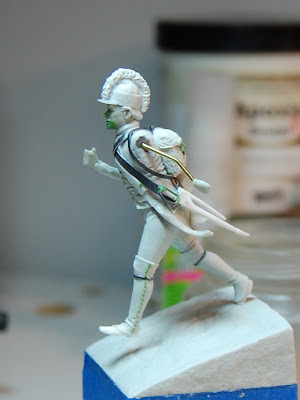
My next project is a French infantryman from the 1790's. Inspiration came from a caption in Osprey's book on the same subject.
I will feature this project in an sbs format and try my best to explain the techniques I use.
I'm always on the lookout for a new pose. Some of my favorite sources are the "big" battle books. Sometimes there can be found neat vignette or single figure ideas within the large picture.
The past few figures of mine have been rather static so this one will be a change and a challenge.
I've added balsa strips to the base to give the "slope" some foundation for putty application.
For the figure, I composed in my usual way. Carefully measuring the length of the legs and torso (I use the figure chart from Mike Blank's book). This is the most critical point for the sculptor and every effort should be used to make sure the proportions measure equally.
I start to flesh out my figures one leg at a time. After each application I score/etch the putty while 80% cured. If I have the time, I will place the figure under a lamp to speed up the curing process and go on to something else. I try to stay busy when waiting for things to dry. During this time I will be working on "building" or cleaning the figures accessories, weapons, gear, etc.
After the legs and trousers have been sculpted/cured, I moved next to the coat-tails. I used rolled out putty and then measure and cut to appropriate shape. Then these are carefully applied to the boddy with super glue and shaped. Since there will be alot of movement with this figure I decided to give the coat-tails some "flow". I set two ink pens under the tails and let cure overnight.

 Here's the finished piece. I won't get into the color mixes for I didn't write any of them down...Which I really should do! Lets say I used pratically every light shade of grey from tan to greenish hues that Vallejo produces. I liked how it turned out and I won't be as intimidated to paint whites again.
Here's the finished piece. I won't get into the color mixes for I didn't write any of them down...Which I really should do! Lets say I used pratically every light shade of grey from tan to greenish hues that Vallejo produces. I liked how it turned out and I won't be as intimidated to paint whites again.



 Here, I've finished the arms and other bits and pieces. The buttons on the leggings are made of Duro. Each leg took atleast 45 minutes each.
Here, I've finished the arms and other bits and pieces. The buttons on the leggings are made of Duro. Each leg took atleast 45 minutes each.





















